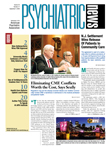A new antipsychotic drug, asenapine, has been approved by the Food and Drug Administration (FDA) for the acute treatment of schizophrenia and manic or mixed episode in bipolar I disorder in adults.
The approval, announced on August 14, came just two weeks after an FDA advisory committee gave a favorable review to the drug at a public meeting. The advisors reviewed three phase 3, placebo-controlled trials of asenapine in patients with schizophrenia and two placebo-controlled trials in patients with a manic or mixed episode of bipolar I disorder.
The drug is expected to be available in U.S. pharmacies beginning in the fourth quarter of this year, according to an announcement by Schering-Plough.
Similar to other second-generation antipsychotics, asenapine is an antagonist of the serotonin 5HT2 and dopamine D2 receptors. Schering-Plough acquired the molecule and took over its development upon the company's merger with Organon BioScience in 2007.
In two of the three phase 3 trials in schizophrenia, asenapine 5 mg twice daily showed significantly greater efficacy, measured by total score on the Positive and Negative Syndrome Scale (PANSS) than did placebo after six weeks of randomized, double-blind, acute treatment. A higher dose of 10 mg twice daily was significantly better than placebo in only one trial. Thus, the company decided to seek approval for the indication of schizophrenia treatment for the dose of 5 mg twice daily only. In a third trial, asenapine at both doses did not beat placebo in the primary endpoint.
In the two bipolar disorder trials, asenapine was given in flexible doses of between 5 mg and 10 mg twice daily for three weeks during an acute manic or mixed episode in a double-blind manner. The primary efficacy measure, improvement from baseline in the Young Mania Rating Scale (YMRS) total score, showed significant advantage for asenapine over placebo.
In these short-term trials, common adverse reactions to asenapine included somnolence, extrapyramidal symptoms, akathisia, oral hypoesthesia, and dizziness.
In a long-term schizophrenia trial, in which asenapine was compared with olanzapine, the mean body weight gain from baseline was 1.6 kg after one year; patients who took olanzapine for one year had a gain of 5.6 kg. Clinically meaningful weight gain (at least 7 percent increase from baseline) occurred in 14.7 percent of patients on asenapine and 36.1 percent on olanzapine.
In the short-term trials, these metabolic indicators, including glucose and cholesterol levels, appeared to be less affected by asenapine than by olanzapine.
In the long-term schizophrenia trial, three of the 908 patients (0.3 percent) treated with asenapine had a QTc interval increase from baseline of greater than 60 msec. None had a QTc interval increase of 500 msec or more.
Ten of the 12 advisory committee members voted to indicate that asenapine has been shown to be effective and acceptably safe as an acute treatment for schizophrenia. Nine agreed that the balance of its effectiveness and safety is acceptable for approval. Three advisors were troubled by the one trial in which asenapine did not beat placebo and were reluctant to support its approval for this indication.
The two positive studies in bipolar I disorder convinced the committee to vote unanimously in favor of the efficacy and safety of asenapine to treat that disorder.
Asenapine is formulated as sublingual tablets to optimize its bioavailability upon absorption, since the drug is extensively metabolized in the liver. The tablet should not be swallowed. The approved dosage for acute schizophrenia treatment is 5 mg twice daily. The dosage for bipolar I disorder is to start with 10 mg twice daily with the option of decreasing to 5 mg twice daily if the patient experiences adverse effects.
At the advisory meeting, the company said it plans to study the drug in pediatric and adolescent populations as well as for long-term maintenance treatment for the two disorders in adults.
Prescribing information for asenapine is posted at<www.spfiles.com/pisaphrisv1.pdf>.▪
